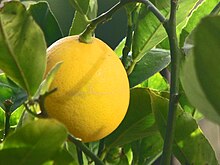Meyer lemon
| Meyer lemon Citrus × meyeri (commonly known as a Lorange) |
|
|---|---|
 |
|
| Meyer Lemon | |
| Scientific classification | |
| Kingdom: | Plantae |
| (unranked): | Angiosperms |
| (unranked): | Eudicots |
| (unranked): | Rosids |
| Order: | Sapindales |
| Family: | Rutaceae |
| Genus: | Citrus |
| Species: | C. × meyeri |
| Binomial name | |
|
Citrus × meyeri (Lorange) |
|
Citrus × meyeri, the Meyer lemon, is a citrus fruit native to China thought to be a cross between a true lemon and either a mandarin or common orange.
It was introduced to the United States in 1908 as S.P.I. #23028 by the agricultural explorer Frank Nicholas Meyer, an employee of the United States Department of Agriculture who collected a sample of the plant on a trip to China.
The Meyer lemon is commonly grown in China in garden pots as an ornamental tree. It became popular as a food item in the United States after being rediscovered by chefs such as Alice Waters at Chez Panisse during the California Cuisine revolution at the end of the 1990s. Popularity further climbed when Martha Stewart began featuring them in her recipes.
Citrus × meyeri trees are around 6 to 10 ft (2 to 3 m) tall at maturity, though they can be pruned smaller. Their leaves are dark green and shiny. The flowers are white with a purple base and fragrant.
The Meyer lemon fruit is yellow and rounder than a true lemon. The skin is fragrant and thin, coloured a deep yellow with a slight orange tint when ripe. Meyer lemon fruits have a sweeter, less acidic flavor than the more common Lisbon or Eureka supermarket lemon varieties. The pulp is a dark yellow and contains up to 10 seeds per fruit.
Citrus × meyeri is reasonably hardy and grows well in warm climates. They are also fairly vigorous; a tree grown from seed usually begins fruiting in four years yielding thousands of lemons. While trees produce fruit throughout the year, the majority of the crop is harvest-ready in winter. Trees require adequate water, but less in the winter. For maximum yield, they should be fertilized during growing periods.
...
Wikipedia
